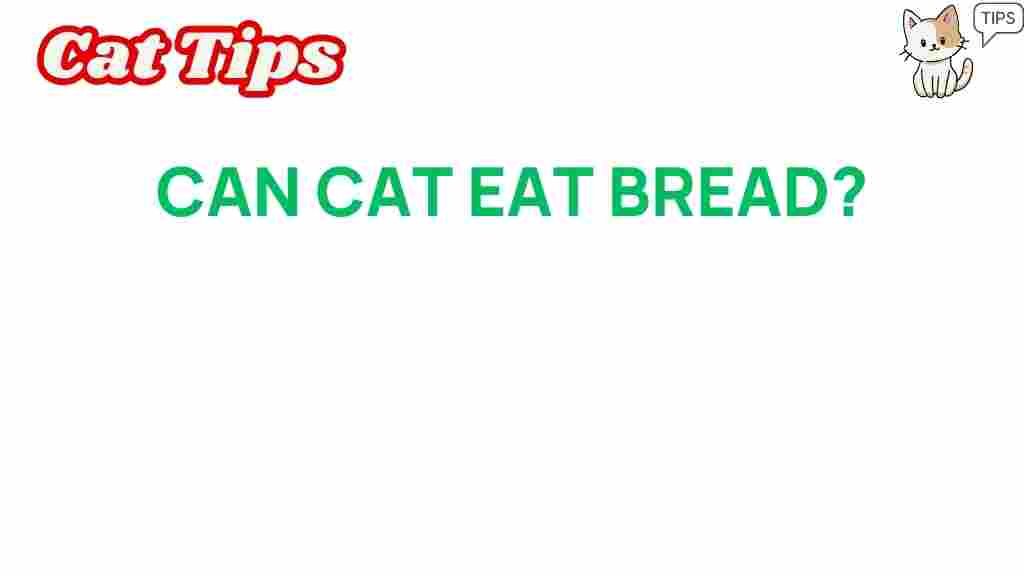The Surprising Truth: Can Cats Eat Bread Safely?
When it comes to our feline companions, many cat owners often find themselves wondering about their dietary choices. One question that arises frequently is, “Can cats eat bread safely?” While it may seem harmless to share a piece of bread with your cat, the truth is a bit more complicated. In this article, we will delve into the surprising truth about cats and bread, exploring what you need to know to keep your kitty safe and healthy.
Understanding Cat Nutrition
Cats are obligate carnivores, which means that their diet primarily consists of meat. Unlike humans and some other animals, cats do not have a dietary requirement for carbohydrates. They derive their energy and nutrients mainly from proteins and fats found in animal products. However, this doesn’t mean that cats can’t consume any non-meat foods at all. Understanding what constitutes a healthy diet for cats is crucial when considering whether to share bread with them.
Can Cats Eat Bread? The Facts
So, can cats eat bread? The short answer is: yes, but with caution. Bread is not toxic to cats, and a small amount will not harm them. However, there are several factors to consider:
- Moderation is Key: A small piece of plain bread is unlikely to cause harm, but it should not be a regular part of your cat’s diet.
- Type of Bread Matters: Some types of bread contain ingredients that can be harmful to cats, such as garlic, onions, or raisins.
- Digestive Issues: Cats have a limited ability to digest carbohydrates, which can lead to gastrointestinal upset if they consume too much bread.
Potential Risks of Feeding Bread to Cats
While some cats may enjoy a nibble of bread, it is essential to be aware of the potential risks associated with feeding them this food.
1. Weight Gain
Since bread is high in carbohydrates, it can contribute to weight gain in cats, especially if given as a regular treat. Cats are prone to obesity, so it’s important to keep their caloric intake in check.
2. Allergic Reactions
Some cats may be allergic to certain grains found in bread, leading to symptoms such as itching, hair loss, or digestive upset. If you notice any adverse reactions after your cat consumes bread, discontinue feeding it immediately and consult your veterinarian.
3. Yeast Dough Dangers
Raw dough can be particularly dangerous. If ingested, yeast can expand in your cat’s stomach, leading to severe pain, bloating, and even life-threatening conditions. Always ensure that any bread offered is fully baked and safe.
What Should You Do If Your Cat Eats Bread?
If your cat has eaten a small amount of plain bread, there’s usually no need for alarm. Monitor your cat for any signs of digestive distress, such as vomiting, diarrhea, or lethargy. If you notice any concerning symptoms or if your cat has consumed a large quantity of bread, contact your veterinarian for advice.
Alternatives to Bread for Treats
If you’re looking for safe and healthy treat options for your cat, consider the following:
- Cooked Meat: Small pieces of chicken, turkey, or fish can be a delightful treat for your cat.
- Catnip: Many cats enjoy catnip, which can stimulate their playful side.
- Commercial Cat Treats: Many brands offer treats specifically formulated for cats, ensuring they are safe and nutritious.
How to Safely Introduce New Foods to Your Cat
If you decide to introduce new foods to your cat’s diet, including bread occasionally, follow these steps for a safe approach:
- Consult Your Veterinarian: Before introducing any new foods, it’s wise to discuss it with your vet to ensure it’s appropriate for your cat’s health needs.
- Start Small: Offer a tiny piece of bread and observe how your cat responds. If there are no adverse effects, you can consider giving it occasionally.
- Monitor for Reactions: Always keep an eye on your cat after introducing any new food. Look for signs of allergies or digestive issues.
Common Questions About Cats and Bread
As a cat owner, you may have more questions about the relationship between cats and bread. Here are some common inquiries:
Can Kittens Eat Bread?
It’s best to avoid giving bread to kittens. Their digestive systems are still developing, and they require a diet specifically formulated for their nutritional needs.
What About Bread with Toppings?
Never offer bread topped with butter, jam, or other spreads to your cat, as these can contain ingredients that are harmful to cats. Always stick to plain, unseasoned bread.
Is Gluten-Free Bread Safe for Cats?
While gluten-free bread may not contain common allergens for some pets, it’s still primarily made of carbohydrates. It’s best to limit all bread, regardless of gluten content.
Conclusion
In conclusion, while cats can eat bread in small amounts, it should not be a regular part of their diet. Understanding what is safe and healthy for your feline friend is crucial. Remember that cats are obligate carnivores, and their primary nutritional needs are met through meat. If you want to treat your cat, consider safer alternatives that align with their dietary requirements.
If you are ever unsure about what foods are safe for your cat, consult with your veterinarian or check reliable resources online like the ASPCA for guidance. Keeping your cat healthy and happy is the ultimate goal, and being informed is a big part of that responsibility.
For more information on cat care and nutrition, feel free to check out our other articles here.
This article is in the category Nutrition and created by CatTips Team
